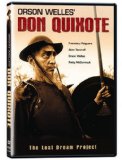| Reviews & Columns |
|
Reviews DVD TV on DVD Blu-ray 4K UHD International DVDs In Theaters Reviews by Studio Video Games Features Collector Series DVDs Easter Egg Database Interviews DVD Talk Radio Feature Articles Columns Anime Talk DVD Savant Horror DVDs The M.O.D. Squad Art House HD Talk Silent DVD
|
DVD Talk Forum |
|
|
| Resources |
|
DVD Price Search Customer Service #'s RCE Info Links |
|
Columns
|
|
|
Orson Welles' Don Quixote
Image // Unrated // August 19, 2008
List Price: $24.98 [Buy now and save at Amazon]
Some things are better off lost than discovered, and Orson Welles' Don Quixote might be one of them. It's kind of like unearthing a long lost treasure chest suspected of containing piles and piles of doubloons, only to see that the weight of the chest is a mix of scant golden nuggets swirled in with a load of outside sedentary dirt. Long believed to be a masterpiece -- rightfully so, coming from the same director as Macbeth and Citizen Kane -- it's difficult to see exactly what Welles' vision truly would've been since its incomplete remnants has been haphazardly pieced back together with secondary additions from director / re-writer Jesus Franco. Featuring added dialogue to fill in many gaps where Welles' didn't get the chance to record his own, Don Quixote instead exists as a tribute piece of sorts that only shows flickers of what could've been in the director's eyes.
The Film:
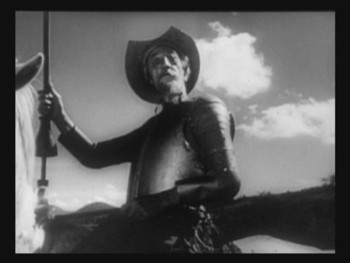
The history behind Welles' Don Quixote, labeled "The Lost Dream Project" here, is a dodgy one filled with a filmmaker's romantic whims. Welles shot his adaptation to Cervantes' novel in gaps during the '50s-'60s and, much like a traveling painter during the Renaissance, dragged some of the footage with him during his travels. Welles tried to edit and rough-cut his whimsical project all throughout that timeframe, even so far as achieving some substantially "final" cuts of the film. Over the years, however, these edits -- along with many portions of the footage shot -- were lost to never be found in their entirety. Along with shooting some rather strong images that truly evoke a modern-yet-authentic spin on Don Quixote, he also added dialogue in himself posing as both Quixote and his knight's errand, Sancho Panza, that was also either lost or not recorded in its entirety.
In 1992, after some finagling work, Welles' project assistant Jesus Franco released a re-pieced together version of the film with bits of footage he could locate and / or purchase. With that, he also enlisted different actors to provide audio in spaces where Welles didn't have the opportunity. Edited together to an overlong, very incomplete 115 minutes or so, it fails to really accomplish anything similar to what we can assume Welles would've wanted. It retains the photography and the non-verbal capturing of dynamics between Francisco Reiguera's Quixote and Mr. Arkadin and Touch of Evil collaborative actor Akin Tamiroff as Sancho Panza, but little else relevant to preserving the narrative. A scene where Quixote attacks a woman riding ("being attacked by") a Vespa scooter with phone lines in the background is an example of one of the visually striking, yet oddly re-vocalized, scenes.
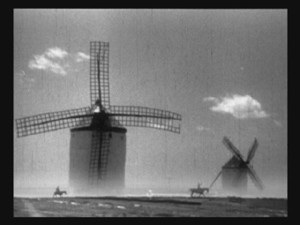
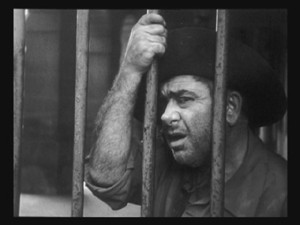
Watching this version of Welles' Don Quixote is akin to peeking inside of the legendary actor / director's brain and filtering his imagination for fleeting raw ideas on how to adapt this story of obsession, insanity, and purity. It retains the visual architecture that consists of beautiful images that paint a glorious black-and-white capturing of Quixote's journey in defending the honor of his fictitious love, Dulcinea. Glancing back at several adaptations of the story on film and television, as well as artwork from from the past, Francisco Reiguera's Quixote is quite authentic and aptly portrayed. His thin visage, harnessing the staved knight's inefficacy, hits the nail on the head in crafting a strained and haunted man with swirling delusions leading his journey. Tamiroff's Panza gets the job done well too, though he's a bit more cynical and unsupportive than the character in the novel.
But then there's the post-record dialogue issue which, to be honest, is very distracting from the pure consumption of the work that Welles' put into the film. There are obvious differentials between the new voiceovers and Welles' original tracks, which concoct an uneasy comfort level with character connection levels. You spend so much time getting used to the different voices that it makes the process of soaking in any thematic strength near impossible. The new voices almost sound like a non-comedic "riff" of the film which, though Welles himself infuses his dialogue and narration with nice pinprick-style humor, really detracts from the natural rhythm. Granted, Welles -- or even Reiguera and Tamiroff -- obviously couldn't record posthumous dialogue, but there's a point when you've got to preserve certain thresholds by making meticulous decisions behind a "restoration". Don Quixote fails to do so, most especially with the additional dialogue scribed by Jesus Franco.
When spliced together, the erratic visual style reminds me of Welles' F for Fake type of editing melded together with Mr. Arkadin-like achievement in black-and-white cinematography. That's the only real reason to see Don Quixote: for Orson Welles' composition. Stretching this clutter of unresolved promise over two hours, however, doesn't bode well for this reconstruction as a film. It's a meagerly enjoyable experience when taken as a glimpse into what could've been, but not nearly the full cinematic vision packed with the majesty that Welles certainly would've intended from his scattershot filming. It was a passion project -- and piecing it together was a noble effort from Jesus Franco -- but the result falls exceedingly short of significance.
The DVD:
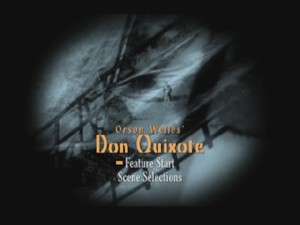
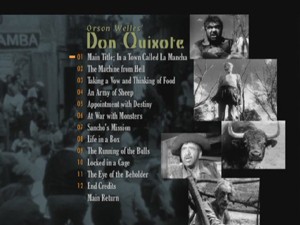
Image Entertainment brings up Orson Welles' Don Quixote in a standard keepcase presentation with similar coverart and discart. It features an attractive image of Reiguera, along with the moniker of it being "Orson Welles'" film -- though it has become more of Franco's project than that of Welles'.
The Video:
As this is a no-budget film with unkempt sources dragged through the '50s and '60s, it'd be safe to assume that Don Quixote's full-frame negative would look pretty darn bad if unpolished -- which it does. First thing to consider is the fact that it's pictureboxed, sporting a rather thick black border around the image to prevent overscan on analog televisions. That's not a huge deterrent, but it does make it so that the visible information is a shade further away that possible. Dust, debris, scratches, grain, and prominent lines are visible throughout the entire image. It's jittery, flickering, and pretty darn disorienting at most times. Maybe the pictureboxing isn't such a bad thing, then. There's the random occurrence where you can make out light and dark contours, like in Reiguera's facial structure and against some of his armor, but the blurriness and lack of detail really wear down the image. You get the gist of Welles' ideas for his cinematography, but that's about all the presentation allows.
The Audio:
Equally as lackluster is the English Stereo track, which does very little to help the presentation along. Popping doesn't occur too much, which was a solid plus, but the way the voices are mixed just didn't sound adept to my ears. You never have any problem with hearing the vocal clarity though, even in the sparse scenes with Welles' original voicing. But audio level rendering of the new voice choices really accentuates the differentiation in tracks. It's suitable and clean, but also a heavy deterrent from the film in its iffy nature.
Extras:
A Scene Selection in Don Quixote is a welcome addition -- since it enables you to skim through and pick-and-choose the scenes you might like to see / show to a class -- though you can hardly call that a supplement. Without that, this disc offers nothing else in extra material: no mentioning of Welles' work, no feature highlighting the new voices, nothing.
-----
Final Thoughts:
If Franco hadn't raised Orson Welles' Don Quixote from the grave, then we would've had a positive-negative situation on our hands. The negative is that we would've never seen the labor that Welles put into his lengthy passion project, along with some rather unique visual tricks and attractive images featuring Reiguera and Tamiroff as the Quixote-Panza duo. But if left in the undercurrent as a rumored masterpiece -- with maybe only a showcase or two of the unaltered footage -- then we wouldn't have to watch the pieces of the puzzle oddly glued together. Rent It, if it's a possibility, just so see the glimmers of Welles' work that he etched into this adaptation of Cervantes' novel, but those expecting a majestic rendering of a masterpiece underneath the legendary director's umbrella will find little agreeable material here.
Thomas Spurlin, Staff Reviewer -- DVDTalk Reviews | Personal Blog/Site
The Film:

The history behind Welles' Don Quixote, labeled "The Lost Dream Project" here, is a dodgy one filled with a filmmaker's romantic whims. Welles shot his adaptation to Cervantes' novel in gaps during the '50s-'60s and, much like a traveling painter during the Renaissance, dragged some of the footage with him during his travels. Welles tried to edit and rough-cut his whimsical project all throughout that timeframe, even so far as achieving some substantially "final" cuts of the film. Over the years, however, these edits -- along with many portions of the footage shot -- were lost to never be found in their entirety. Along with shooting some rather strong images that truly evoke a modern-yet-authentic spin on Don Quixote, he also added dialogue in himself posing as both Quixote and his knight's errand, Sancho Panza, that was also either lost or not recorded in its entirety.
In 1992, after some finagling work, Welles' project assistant Jesus Franco released a re-pieced together version of the film with bits of footage he could locate and / or purchase. With that, he also enlisted different actors to provide audio in spaces where Welles didn't have the opportunity. Edited together to an overlong, very incomplete 115 minutes or so, it fails to really accomplish anything similar to what we can assume Welles would've wanted. It retains the photography and the non-verbal capturing of dynamics between Francisco Reiguera's Quixote and Mr. Arkadin and Touch of Evil collaborative actor Akin Tamiroff as Sancho Panza, but little else relevant to preserving the narrative. A scene where Quixote attacks a woman riding ("being attacked by") a Vespa scooter with phone lines in the background is an example of one of the visually striking, yet oddly re-vocalized, scenes.


Watching this version of Welles' Don Quixote is akin to peeking inside of the legendary actor / director's brain and filtering his imagination for fleeting raw ideas on how to adapt this story of obsession, insanity, and purity. It retains the visual architecture that consists of beautiful images that paint a glorious black-and-white capturing of Quixote's journey in defending the honor of his fictitious love, Dulcinea. Glancing back at several adaptations of the story on film and television, as well as artwork from from the past, Francisco Reiguera's Quixote is quite authentic and aptly portrayed. His thin visage, harnessing the staved knight's inefficacy, hits the nail on the head in crafting a strained and haunted man with swirling delusions leading his journey. Tamiroff's Panza gets the job done well too, though he's a bit more cynical and unsupportive than the character in the novel.
But then there's the post-record dialogue issue which, to be honest, is very distracting from the pure consumption of the work that Welles' put into the film. There are obvious differentials between the new voiceovers and Welles' original tracks, which concoct an uneasy comfort level with character connection levels. You spend so much time getting used to the different voices that it makes the process of soaking in any thematic strength near impossible. The new voices almost sound like a non-comedic "riff" of the film which, though Welles himself infuses his dialogue and narration with nice pinprick-style humor, really detracts from the natural rhythm. Granted, Welles -- or even Reiguera and Tamiroff -- obviously couldn't record posthumous dialogue, but there's a point when you've got to preserve certain thresholds by making meticulous decisions behind a "restoration". Don Quixote fails to do so, most especially with the additional dialogue scribed by Jesus Franco.
When spliced together, the erratic visual style reminds me of Welles' F for Fake type of editing melded together with Mr. Arkadin-like achievement in black-and-white cinematography. That's the only real reason to see Don Quixote: for Orson Welles' composition. Stretching this clutter of unresolved promise over two hours, however, doesn't bode well for this reconstruction as a film. It's a meagerly enjoyable experience when taken as a glimpse into what could've been, but not nearly the full cinematic vision packed with the majesty that Welles certainly would've intended from his scattershot filming. It was a passion project -- and piecing it together was a noble effort from Jesus Franco -- but the result falls exceedingly short of significance.
The DVD:


Image Entertainment brings up Orson Welles' Don Quixote in a standard keepcase presentation with similar coverart and discart. It features an attractive image of Reiguera, along with the moniker of it being "Orson Welles'" film -- though it has become more of Franco's project than that of Welles'.
The Video:
As this is a no-budget film with unkempt sources dragged through the '50s and '60s, it'd be safe to assume that Don Quixote's full-frame negative would look pretty darn bad if unpolished -- which it does. First thing to consider is the fact that it's pictureboxed, sporting a rather thick black border around the image to prevent overscan on analog televisions. That's not a huge deterrent, but it does make it so that the visible information is a shade further away that possible. Dust, debris, scratches, grain, and prominent lines are visible throughout the entire image. It's jittery, flickering, and pretty darn disorienting at most times. Maybe the pictureboxing isn't such a bad thing, then. There's the random occurrence where you can make out light and dark contours, like in Reiguera's facial structure and against some of his armor, but the blurriness and lack of detail really wear down the image. You get the gist of Welles' ideas for his cinematography, but that's about all the presentation allows.
The Audio:
Equally as lackluster is the English Stereo track, which does very little to help the presentation along. Popping doesn't occur too much, which was a solid plus, but the way the voices are mixed just didn't sound adept to my ears. You never have any problem with hearing the vocal clarity though, even in the sparse scenes with Welles' original voicing. But audio level rendering of the new voice choices really accentuates the differentiation in tracks. It's suitable and clean, but also a heavy deterrent from the film in its iffy nature.
Extras:
A Scene Selection in Don Quixote is a welcome addition -- since it enables you to skim through and pick-and-choose the scenes you might like to see / show to a class -- though you can hardly call that a supplement. Without that, this disc offers nothing else in extra material: no mentioning of Welles' work, no feature highlighting the new voices, nothing.
-----
Final Thoughts:
If Franco hadn't raised Orson Welles' Don Quixote from the grave, then we would've had a positive-negative situation on our hands. The negative is that we would've never seen the labor that Welles put into his lengthy passion project, along with some rather unique visual tricks and attractive images featuring Reiguera and Tamiroff as the Quixote-Panza duo. But if left in the undercurrent as a rumored masterpiece -- with maybe only a showcase or two of the unaltered footage -- then we wouldn't have to watch the pieces of the puzzle oddly glued together. Rent It, if it's a possibility, just so see the glimmers of Welles' work that he etched into this adaptation of Cervantes' novel, but those expecting a majestic rendering of a masterpiece underneath the legendary director's umbrella will find little agreeable material here.
|
| Popular Reviews |
| Sponsored Links |
|
|
| Sponsored Links |
|
|
| Release List | Reviews | Shop | Newsletter | Forum | DVD Giveaways | Blu-Ray | Advertise |
|
Copyright 2024 DVDTalk.com All Rights Reserved. Legal Info, Privacy Policy, Terms of Use,
Manage Preferences,
Your Privacy Choices | |||||||









